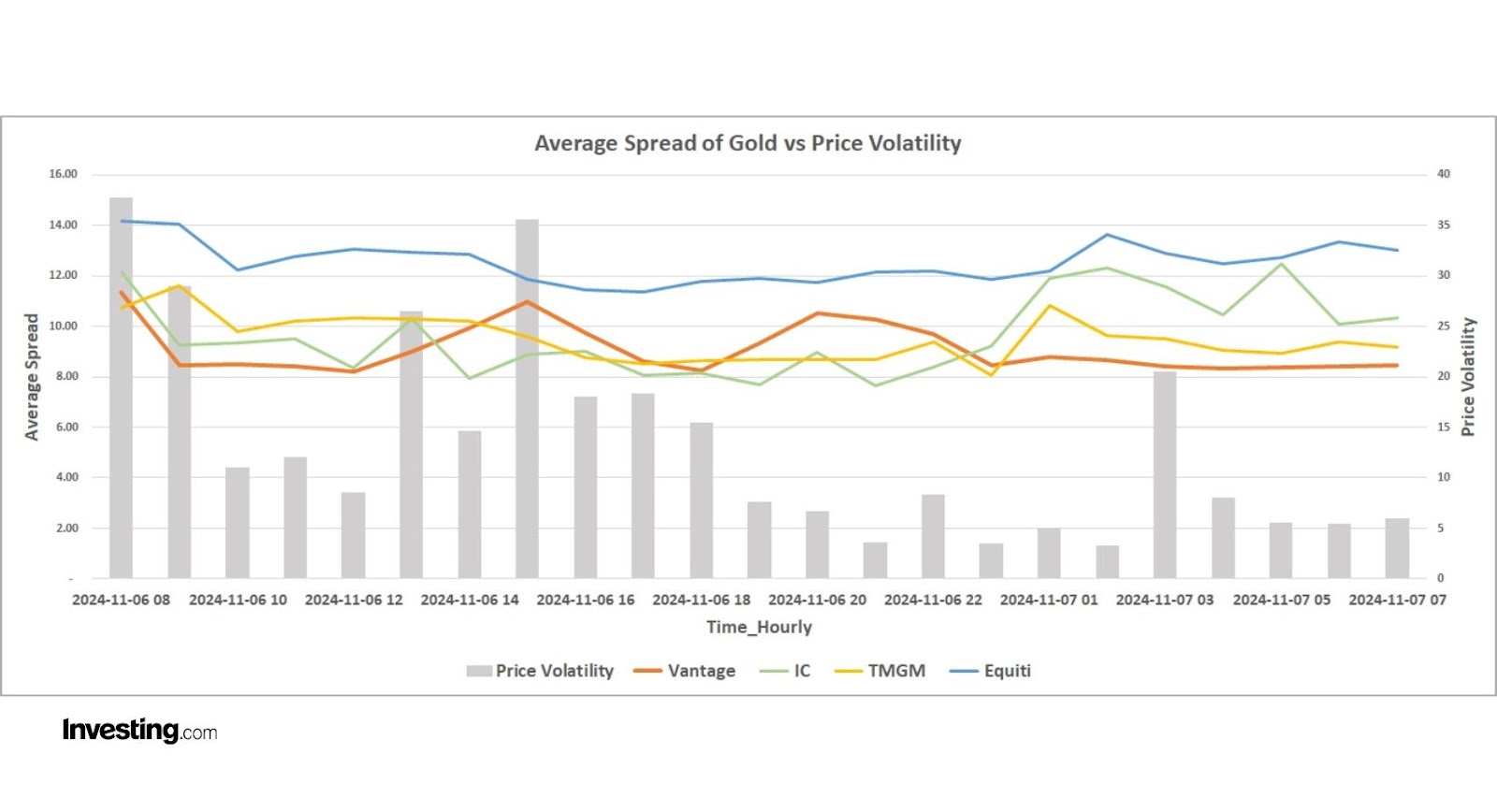Gold trading: Evaluating broker performance amid US election volatility
2024.11.13 05:03
Investing.com – As the U.S. election unfolded, traders anticipated heightened market volatility, particularly in the Gold () market. This scenario provided a unique opportunity to assess the trading environments offered by key brokers, including Vantage, IC Markets, TMGM, XM, and Equiti across several criteria: leverage, spread value, spread volatility, non-slippage rate, market depth, large order costs, and swap costs.
Selecting Brokers and Methodology
The brokers were chosen based on their significant market-share footprints worldwide. With IC Markets and XM positioned as global leaders in trading volume, TMGM’s firm establishment in Southeast Asia, and Equiti’s notable standing in the Middle East, the selection offers a diverse set of approaches to the market. As one of the fastest-growing fintech brokers, Vantage’s global reach also made it a necessary part of the comparative analysis. This diverse selection reflects the varied market strategies and target markets of each broker, providing a comprehensive analysis of the conditions they offer.
To get a full picture of their trading capabilities, assessments utilized both ECN and STP accounts. ECN accounts are ideal for offering direct market access with tighter spreads, crucial for cost-sensitive traders navigating volatile periods. In contrast, market STP accounts, with their stable spreads and reduced slippage, cater to traders seeking dependability, especially during major events like the U.S. elections. This dual approach ensures that the assessment reflects the preferences and needs of a broad spectrum of traders.
Understanding ECN and STP Accounts
ECN (Electronic Communication Network) accounts allow direct access to the financial markets, which results in tighter spreads that are vital for cost-sensitive traders, especially during volatile times. This direct market access bypasses intermediaries, offering a potentially faster execution and lower spreads, albeit with a commission per trade.
In contrast, STP (Straight Through Processing) accounts route orders directly through liquidity providers, aiming for stable spreads and low slippage. This makes STP accounts appealing to traders who prioritize a steady trading environment without the complexity of varying commission structures, especially relevant when market fluctuations intensify during events like the U.S. elections.

Spread Stability Under the Microscope
A stable spread is a key indicator of reliability, especially after major announcements like election results. The study highlighted that Equiti maintained tighter spreads, fluctuating around 3 points, with Vantage following closely. Vantage, TMGM, and IC Markets averaged around 9 points throughout the day, but during periods of high price volatility, these spreads fluctuated between 8 and 12 points. As the market gradually stabilized, Vantage’s spread remained more stable, staying closer to 8-9 points compared to its competitors. However, Vantage emerged as the most cost-effective option for executing large orders, with the lowest large order cost among the brokers assessed. Stable spreads and efficient handling of large orders ensure predictable costs when entering and exiting trades.

Evaluating Swap Costs
Swap costs are crucial for traders holding positions overnight, as they represent the fees incurred for doing so. These costs can significantly influence overall profitability, especially during periods of market turbulence. The data shows notable differences in swap charges among brokers. Vantage consistently offered competitive rates, with a long swap rate of -30.8 and a short swap rate of 22. This predictability provides traders an edge by minimizing overnight fees. Such stable rates are particularly advantageous for longer-term trades, allowing for more strategic planning.
Comparatively, IC Markets exhibited a long swap rate of approximately -32.84 and a short rate of 20.78. While similar, these rates slightly impact cost efficiency. Other brokers, like TMGM and XM Global, displayed varying rates, ranging from as low as -36.21 for TMGM’s long positions to XM Global’s consistent -50.89, which could affect traders’ longer-term financial outcomes.
Implications of Leverage
Leverage is essential for tailoring trading strategies to align with individual risk appetites. In terms of leverage, Vantage set itself apart with up to 1:2000 for Premium Accounts, offering traders considerable flexibility. Meanwhile, IC Markets, TMGM, and XM maintained a steady 1000:1, providing a solid, if less adaptable, offering. Equiti’s decision to reduce leverage to 500:1 signals a cautious approach during unstable market times. Understanding these variations is crucial for traders aiming to optimize their strategies and manage risk effectively.
Conclusion
As markets settled after the U.S. election, distinct patterns in broker performance emerged. However, it’s important to note that, contrary to expectations, this event did not drastically impact trading conditions for most of the tested brokers as they managed to maintain market stability amidst anticipated volatility.
Overall, Vantage led across many metrics and demonstrated its adaptability across multiple criteria, establishing a solid footing for traders needing a reliable ally in uncertain markets. Whether through competitive leverage options or its reliable execution marked by a 79% no-slippage rate, Vantage’s stability stood out.
While this analysis underscores the importance of choosing a broker that aligns with strategic goals, especially during market upheavals, be sure to conduct your own research. By leveraging these insights, traders can better navigate the complexities of the gold market and enhance their trading outcomes, ensuring a blend of stability and opportunity in uncertain times.








